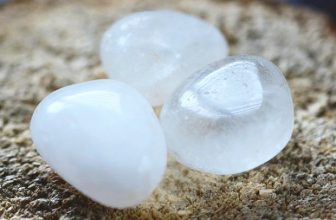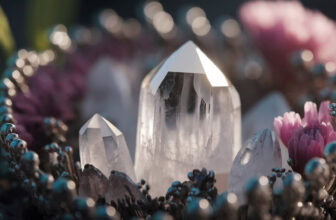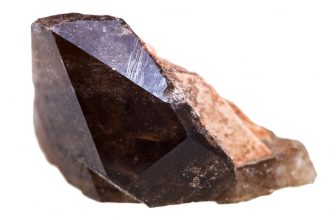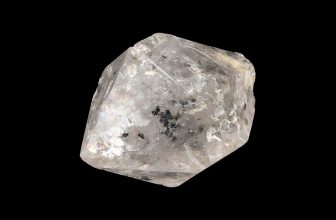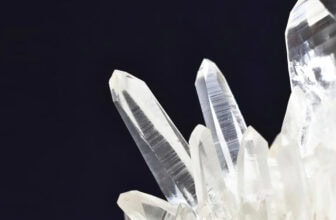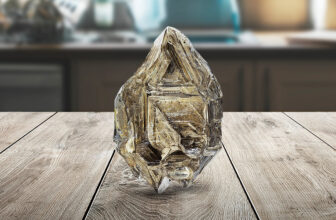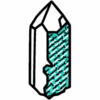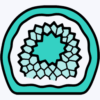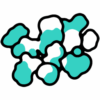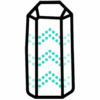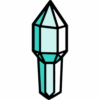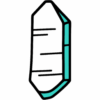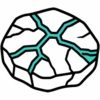When Crystals Grow in Two Directions: Double Terminated Points
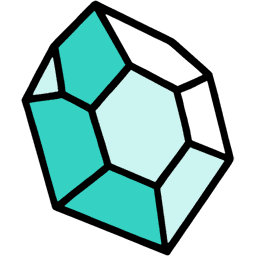
Why These Two-Ended Wonders Matter More Than You Think
Ever felt pulled in two directions at once – by stress, decisions, or the pressure to stay balanced while everything around you moves too fast? Double terminated crystals speak directly to that feeling. They’re unusual, elegant, and strangely reassuring. But what are they, really?
At their simplest, double terminated crystals are minerals that develop a natural termination – a true crystalline point – on both ends. No human shaping. No polishing tricks. Just pure geometry created by nature. Most crystals grow attached to a host rock, leaving only one point free to develop, which is why typical single-terminated points are far more common. DTs break that rule entirely. They grow in open space, suspended like tiny mineral astronauts, forming two naturally faceted tips.
This quirky growth habit is exactly what makes them so beloved. Collectors admire their symmetry. Jewelry makers appreciate their sculptural beauty. And metaphysical practitioners? They’re drawn to the idea of energy moving in two directions at once – flowing, looping, balancing.
If you’ve ever wondered why some crystals feel especially “alive” in your hand, this form has a lot to do with it.
How Double Terminated Crystals Form in Nature
When Crystals Grow Without Constraints
Why do some minerals develop two perfect tips while others remain rooted and one-sided? The answer begins in the pockets where they’re born. Imagine a crystal forming inside an open cavity – a vug, a geode, even a tiny seam filled with fluid. With no rock pressing on its sides, the growing crystal is free to extend upward and downward.
In these free-floating environments, molecules stack themselves neatly at both ends, building matching (or sometimes intriguingly mismatched) terminations. Whether the crystal ends up elongated like a wand or short and chunky depends on the space available and the rhythm of its growth. Some expand slowly and steadily; others surge, pause, and grow again, producing stepped or layered tips.
The magic is that both terminations grow for the same reason: nothing is in the way.
The Surrounding Matrix: Supportive or Restrictive?
Here’s another question: what happens when a crystal is only barely attached to host rock?
Quite a lot, actually.
Sometimes DTs form with just a single point anchored to rock, and as fluids move or mineral-rich pockets shift, they break free and continue growing in open space. Other times, minerals grow between soft or dissolving materials – clays, calcite layers, or ephemeral pockets that later erode away – leaving the crystal perfectly terminated at both ends.
The key players here are hydrothermal fluids. These mineral-rich waters circulate through fractures, carrying dissolved elements that later crystallize. When the fluid flow is slow and uninterrupted, terminations develop cleanly. When conditions change – more heat, less space, abrupt cooling – the crystal may develop quirky tips, multiple terminations, or re-healed ends.
Nature has many ways of saying, “Let’s try that again.”
Localities That Produce the Finest Examples
If you’re wondering where these free-floating crystals come from, some regions are famous for them. Herkimer County in New York produces water-clear quartz DTs so brilliant they’re called “Herkimer diamonds.” In Pakistan’s high-altitude pegmatites, double terminated quartz and aquamarine form in wide pockets with astonishing clarity. Brazil contributes amethyst and smoky quartz DTs, while Arkansas offers pristine quartz clusters where DTs occasionally break free as perfect individuals.
The unifying theme across all these places?
Space.
Slow growth.
Patience – geologic patience so immense it feels like a quiet spell cast inside the earth.
What Makes Them So Striking
Two Points, One Story
Ever notice how some crystals seem to “speak” through their shape? Double terminated points do exactly that. Their two natural tips create a visual rhythm – almost like an inhale and exhale held in solid form. Some are long and wand-like, ideal for directing energy. Others are short, chunky, or tabular, giving them a grounded, compact look.
Symmetry is often part of their charm, but not a requirement. Some DTs develop one sharp, precise termination and one softer, more rounded one. Nature doesn’t mind bending the rules a little. And in those variations, you’ll often find the story of the crystal’s growth journey written in angles, edges, and shifting faces.
A Closer Look
Why do people sometimes gasp when they see a high-grade DT in person? Clarity. Or color. Or a texture that seems almost otherworldly.
Double terminated crystals may be perfectly transparent – like Herkimer quartz – or deep and saturated, as seen in tourmaline or amethyst. Many include tiny worlds inside: wispy veils, bubbles of ancient fluid, flecks of hematite, or mesmerizing phantoms that reveal earlier growth stages.
Textures vary too. Some have smooth, cool surfaces; others show faint etching that gives them a subtly weathered feel. These surface patterns aren’t imperfections – they’re geological fingerprints, hints of water flow, dissolution, or re-healing.
What Makes a Tip “Good”?
Collectors often ask: How do you judge a crystal’s termination?
Sharpness is one factor. Cleanly defined faces are another. A beautifully formed termination will have crisp geometry with minimal damage or chipping.
But here’s the twist: some DTs naturally form stepped, layered, or slightly uneven tips due to growth interruptions. Those features aren’t flaws – they’re markers of the crystal’s complex life. You might even spot phantoms near the terminations, tiny internal “ghost crystals” pointing to earlier growth phases.
In other words, the value of a DT isn’t only in perfection; it’s in personality.
More Than One Kind
Naturally Double Terminated Crystals
Some crystals form fully detached inside pockets or geodes, developing terminations without any contact on their sides or ends. These are the purists – the true free-growers. Minerals like quartz, topaz, and calcite commonly appear in this form when conditions are ideal.
Their completely unrestrained growth often results in elegant proportions and high clarity, which is why collectors cherish them.
DTs Hidden in Clusters
Here’s a delightful surprise: even crystals growing in clusters can produce DTs. If a crystal is surrounded by other points but still has enough space at its ends, it may form tips on both sides. These cluster-based DTs often look more organic and less symmetrical, giving them a raw, natural charm.
You’ll sometimes see them perched horizontally, wedged between neighbors like overachievers determined to grow in both directions anyway.
Specialty Double Terminated Forms
Some crystals take the DT concept and crank the intensity up a notch:
- Double Terminated Scepters – growth where a secondary crystal forms like a crown at one end, mirrored on the opposite end, creating a dramatic dual-ended structure.
- DT Elestials – complex, layered, and often smoky or amethystine, with multiple terminations and intricate stair-step faces.
- Double Terminated Twins – two crystals sharing part of their structure, each with terminations at both ends; a visually captivating and energetically unique formation.
These variations feel almost architectural, like minerals that borrowed design cues from ancient temples.
Pseudo Double Terminations: Almost, But Not Quite
Not every crystal with two pointed ends is a true DT. Some crystals break during growth and later re-heal, forming a new termination on the broken side. These re-healed tips often have a frosted, cascading, or mosaic texture that differs from the original termination.
Others may show partial tips – semi-formed but not complete. These are sometimes called “near DTs,” and while they’re not fully symmetrical, they still hold a distinct kind of beauty.
How to Spot the Real Deal: Identifying & Authenticating DTs
Natural or Shaped? How to Tell the Difference
Ever picked up a crystal and wondered whether both tips were truly natural – or the result of a clever polish job? It happens more often than people think. The quickest way to tell is by looking closely at the crystal’s growth patterns. Natural DTs show subtle, uninterrupted lines running from the body straight into each termination. These striations don’t stop abruptly; they flow and taper organically.
Artificially shaped points, on the other hand, look too smooth. Their surfaces can appear uniform and slightly glassy, lacking the fine faces and micro-angles that occur naturally. Polished tips may also round off edges instead of producing the crisp geometry real terminations display.
If a point looks perfect in a way that feels suspiciously machine-made, trust your intuition – then look for growth textures to confirm.
Common Misidentifications & Confusions
One of the most frequent errors is assuming a damaged crystal with a chipped base is “almost double terminated.” Unfortunately, breaks don’t count, even if they look somewhat pointed. A true termination always shows defined faces arranged in a geometric pattern, not jagged or conchoidal fractures.
Another mix-up happens with partially healed ends. These can look like rough terminations but lack the symmetry, transparency, or clear facet structure of a fully developed tip. They’re beautiful in their own way, but they don’t meet the criteria of a natural DT.
Finally, many beginner collectors encounter polished wands or “reconstructed” double points – two broken crystals fused together with resin. These usually reveal themselves through bubbles, adhesive lines, or mismatched clarity between the two ends.
What Determines Value
What makes one DT worth a few dollars and another worth a small fortune? A blend of factors:
- Clarity – especially important in quartz. Eye-clean DTs are especially prized.
- Symmetry – not required, but highly desirable for collectors.
- Mineral Species – DT tourmalines or topaz can command impressive prices.
- Locality – Herkimer quartz from New York, Shigar Valley aquamarine from Pakistan, and Arkansas DT clusters carry premium appeal.
- Termination Quality – clean, undamaged tips significantly increase value.
- Size – larger DTs are uncommon, especially in fragile minerals like calcite.
A small, perfect DT can be more valuable than a large, heavily included one. In this formation, quality outweighs quantity every time.
Crafting, Wearing & Preserving
Lapidary Considerations: When to Shape & When to Protect
Lapidaries often face a dilemma: shape the crystal into jewelry, or preserve its natural terminations? For double terminated pieces, preservation is almost always the priority. Those two tips are the whole point – the identity – of the formation.
Cutting or reshaping a DT risks removing the very feature that makes it special. Instead, jewelers usually design around the natural form, creating settings that support but don’t cover the ends. Wire wrapping, minimalistic prong settings, and cage-style holders are common solutions.
Because DTs can be fragile – especially at their tips – cutters must handle them with delicacy. One careless touch of a grinding wheel can change a perfect termination forever.
Spiritual & Metaphysical Associations
Why Two Terminations Change Everything
Ever feel like your energy is pulled outward and inward at the same time? Double terminated crystals mirror that sensation beautifully. Their two natural points symbolically – and, for many practitioners, energetically – allow energy to move in both directions. Instead of simply radiating outward like a single-terminated point, DTs create a loop, a flow, a bridge.
Many people describe them as “amplifiers with a purpose.” They don’t just boost energy; they connect two points – two ideas, two people, two chakras, two moments of emotional intensity. They act as conduits.
Whether you see that as metaphysics or metaphor, the symbolism is undeniably powerful.
How Practitioners Use Double Terminated Crystals
Their balanced geometry makes DTs adaptable tools. Here are common uses among energy workers:
- Meditation: Holding a DT can help maintain focus, especially when juggling thoughts or emotions.
- Balancing Chakras: Placed between two chakras, a DT is believed to harmonize their interplay.
- Energy Bridges: Practitioners use them to connect two crystals in a grid for smoother energy flow.
- Clearing Blockages: Some place DTs on tension points – physical, emotional, or energetic – to support release.
- Communication Tools: They’re often used during difficult conversations as symbolic mediators.
The underlying theme? Connection. DTs are the diplomats of the mineral world.
Properties Vary by Mineral Type
While the shape defines how energy is believed to move, the mineral species adds its own flavor. For example:
- Quartz (Clear, Smoky, Amethyst, etc.)
Known for amplification, clarity, and focus. A double terminated quartz feels like a multi-directional spotlight. - Tourmaline (especially Black or Multi-Colored Variants)
Offers grounding with dynamic flow – a bit like stabilizing yourself while still allowing movement. - Calcite DTs
Gentle, soothing, often connected to emotional processing and soft release. - Fluorite
Helps with mental clarity; in double terminated form, some say it helps weave scattered thoughts into coherence.
Each mineral brings its personality, but the dual-tip structure adds the theme of circulation, balance, and exchange.
Minerals Most Likely to Surprise You as Double Terminated Forms
The Quartz Family: The Main Event
Quartz is the undisputed champion of DT formations. Clear quartz is common, but double terminated versions of smoky quartz, amethyst, citrine, and even rutilated quartz appear regularly.
The star of the show is, of course, the famous Herkimer diamond – a dazzling, ultra-clear quartz DT known for its exceptional brightness and naturally clean facets.
Other Minerals That Love This Shape
Many minerals produce DTs when conditions allow, including:
- Tourmaline (schorl, elbaite, and bicolor varieties)
- Topaz
- Calcite
- Fluorite (particularly octahedral or modified forms that finish as DTs)
- Apatite
- Epidote
- Danburite
These DTs can be more fragile or rare, but their varied colors make them incredibly collectible.
Rare, Unusual & Blink-and-You-Miss-Them Occurrences
A few minerals form DTs so rarely that finding one feels like discovering treasure. Think:
- Beryl (Aquamarine or Morganite) DTs – extremely scarce, often from high-altitude pockets
- Garnet DTs – unusual and highly prized
- Barite DTs – delicate and typically tiny
- Sphalerite DTs – exceptional when found
These rarities tend to command higher prices due to their limited supply and fragile beauty.
How DTs Are Used in Healing Practices & Energy Work
Bridging, Linking & Transferring Energy
Ever had days when your energy feels scattered – half of you in the past, half in the future? Double terminated crystals address that tug-of-war feeling. In many healing traditions, they’re believed to act like conduits, helping energy move smoothly between two points. Rather than radiating energy in only one direction, they’re seen as carriers, linking intention from one space to another.
Practitioners often place DTs between two chakras or two crystals to create a “bridge.” The idea is simple: if energy moves from point A to point B, a DT can keep that flow clean, stable, and continuous. Whether you take that literally or symbolically, the concept has an intuitive elegance – DTs help things connect.
Using DTs in Grids & Layouts
When building a crystal grid, people often wonder: Where should the double terminated points go? A common approach is to use them as connectors – aligning DTs so that each tip points toward another crystal in the layout. This creates directional flow, helping the grid feel cohesive and intentional.
In body layouts, practitioners may place a DT along the spine or at a joint – especially where energy seems stuck. Others use them during breathwork, holding a DT horizontally to symbolize the ebb and flow of the inhale and exhale.
The versatility is part of the charm. One crystal, many possibilities.
Personal Use: Keeping the Flow Close
A lot of people carry small DTs as pocket companions. There’s something comforting about the symmetry – like holding equilibrium in your hand. Some keep a DT on their desk during stressful days to encourage mental clarity. Others use them during meditation, shifting the crystal from palm to palm as they focus on inhale, exhale, release.
Jewelry is another beloved choice. A DT pendant feels almost like wearing a symbol of balance and movement – energy in, energy out, but not overwhelming. Just steady. Just flowing.
How to Choose a Worthwhile Double Terminated Crystal
What to Look For When Selecting a DT
Shopping for double terminated crystals can feel thrilling – but also a little overwhelming. Here’s what experienced collectors tend to focus on:
- Termination Quality: Check both tips. Are they sharp? Complete? Naturally formed?
- Authenticity: Look for natural growth lines and subtle facet patterns. Polished tips look overly smooth.
- Clarity & Color: Choose what speaks to you – gemmy, included, smoky, vibrant. Quality varies by mineral type.
- Damage: DTs are prone to chipped tips. A tiny nick may be fine for personal use, but collectors often prefer pristine ends.
- Shape & Symmetry: Some people love perfect symmetry; others prefer unusual proportions or “character crystals.”
- Locality: Certain regions – Herkimer County, Shigar Valley, Minas Gerais – are known for exceptional specimens.
- Mineral Species: Quartz is most common; rarer DT minerals can be significantly more valuable.

